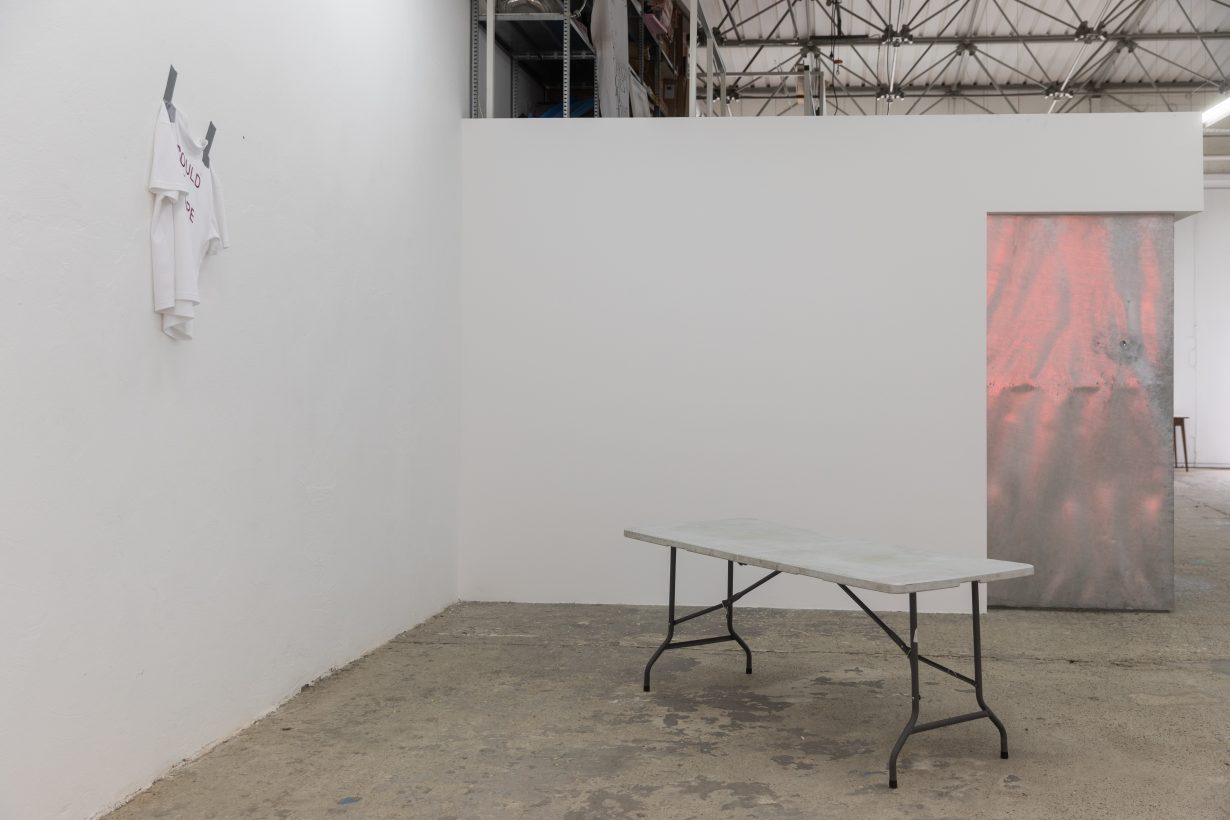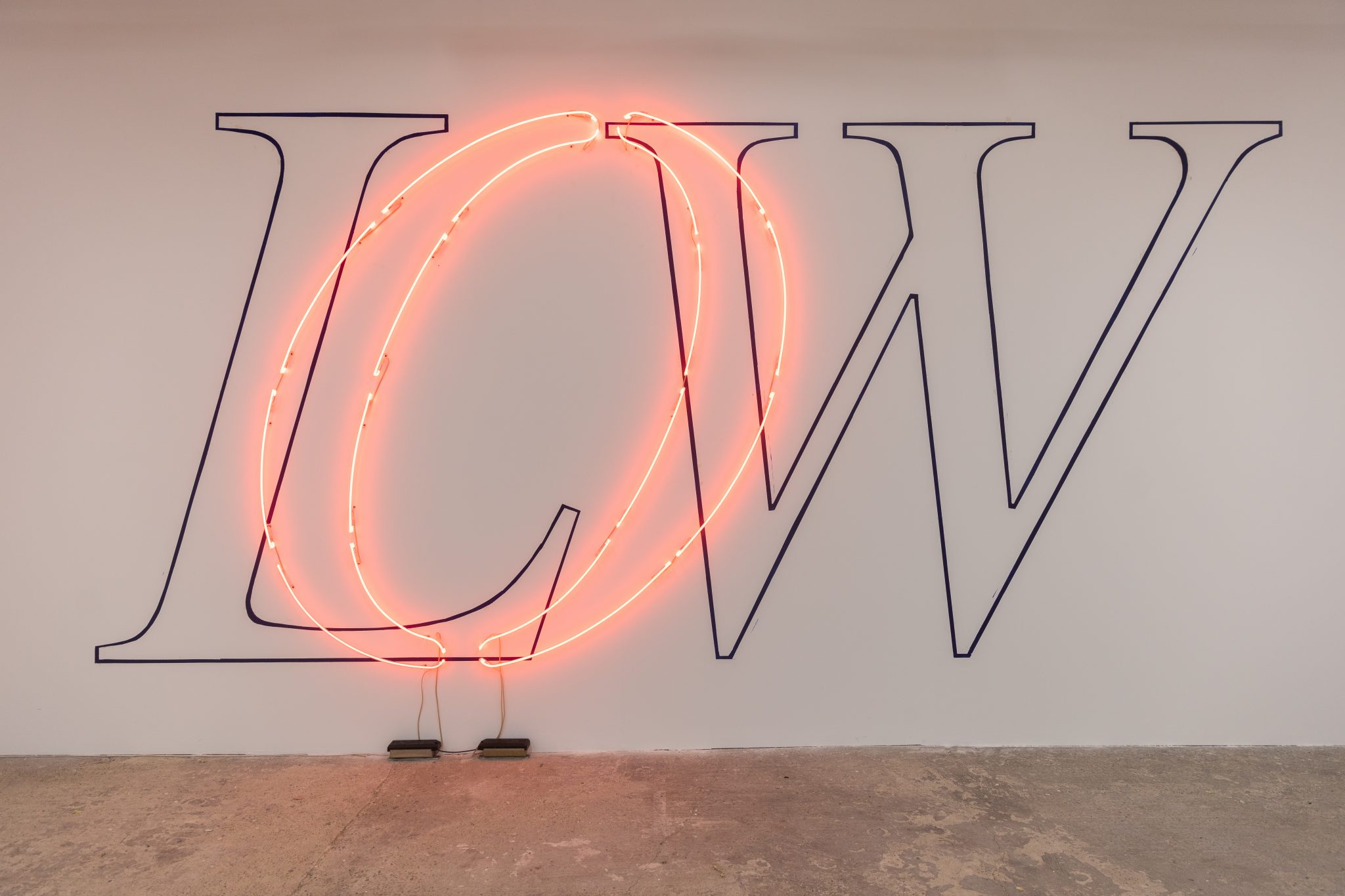Tkačenko’s I Could Live In Hope at Eugster, Belgrade remembers the slowcore band, and a past he can never retrieve
‘Low was an American indie rock band from Duluth, Minnesota, formed in 1993 by Alan Sparhawk and Mimi Parker.’ This is the only information presented in Serbian artist Saša Tkačenko’s exhibition I Could Live in Hope, titled after the band’s 1994 debut album. The sentence is acetone-printed small onto a pale brown plasterboard, a poster-sized work titled The Band (all works 2024). Perhaps it’s the only information you need. After all, Tkačenko’s show is an exploration of absence, of looking at the place where nothing is, or rather, where nothing is anymore.
At first glance Tkačenko’s show is spare. Including the plasterboard, there are only four works in the whole gallery, located in a metal hangar on Belgrade’s industrial outskirts. The word ‘LOW’ appears large on the far wall opposite the entrance, each letter perhaps three metres tall. The O is italicised and bright, a luminous sunset-red neon. The light shimmers in the reflection of the gallery’s metal doors, the gallery silent save for the neon, fizzing quietly like feedback from a guitar amp. The L and W appear darkened, as if suffering from an outage; look closer and they are in fact painted onto the white wall, dark blue stencils, with chips and flecks of paint left from the tape’s peeling-off. Opposite, a plastic foldout table stands at an angle from the wall; the track list of Low’s album is scratched in capitals into the dirty surface. It takes a certain angle of the light to spot it. Duct-taped to the wall behind it is a white T-shirt with the album’s title printed in red, like the last stock remaining from a long-abandoned concert merch stand. Physically, that’s all there is.

After Parker died of ovarian cancer in 2022, the group cancelled shows and has shown little sign of returning. Here Tkačenko has reconstructed the band by the bare signs of its early existence: its name adorning the back wall like a stage scrim, perhaps; its merch diligently sold at the back; its promotional poster reduced to the facts – name, place, constituent members. The performers are gone, the audience has dispersed and all this space: waiting to be filled, but by what? By their unlikely return? Or rather by a memory, of music and melody, those nonverbal signifiers of our existence and how we feel, or how we felt one day? There’s always been a spiritual element to music, and Low wrought something spiritual from their sparse, slowcore rock that often felt as at home in a chamber as in a rock club. Surrounded by the US grunge and shoegaze boom, Low’s trudging, funereal songs – clean guitar lines that wander through melodic progressions, drumming so restrained as if played under duress, vignettes of yearning and regret delivered by Sparhawk’s anguished but raspy wails and Parker’s crystalline legato – captured an emotional ennui at the heart of 1990s rock music: a sense of longing and restlessness, but equally, and as a result, a conviction that there must be more to life, or a life beyond.
There’s a politics lurking in Tkačenko’s show too: the letters, red and blue, on these vast white walls echo the colours of the Serbian flag (‘Low’ perhaps a literal comment on the mood of the nation); the album’s release date harks back to the thick of the Balkan wars, when, for a then-teenage Tkačenko, we might assume Belgrade was a city in which joy and imaginative escape were rare and to be savoured. Indeed, today Serbia’s far-right leaders face protests against electoral fraud in recent elections, and are accused of persecuting opposition leaders who express dissent, while hosting nationalist rallies in Belgrade’s main square. Liberal protest movements have splintered and petered out. On the city’s outskirts, Tkačenko’s show reaches into a tumultuous past in search of something to hold onto, and recuperate.
I Could Live in Hope at Eugster, Belgrade, through 17 August
